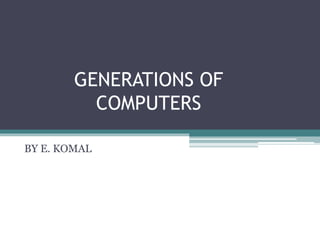GENERATIONS OF COMPUTERS.pptx
•Download as PPTX, PDF•
0 likes•7 views
details of generation of computer
Report
Share
Report
Share

Recommended
Recommended
More Related Content
Similar to GENERATIONS OF COMPUTERS.pptx
Similar to GENERATIONS OF COMPUTERS.pptx (20)
Bangladesh university of business & technology

Bangladesh university of business & technology
Recently uploaded
https://app.box.com/s/4hfk1xwgxnova7f4dm37birdzflj806wGIÁO ÁN DẠY THÊM (KẾ HOẠCH BÀI BUỔI 2) - TIẾNG ANH 8 GLOBAL SUCCESS (2 CỘT) N...

GIÁO ÁN DẠY THÊM (KẾ HOẠCH BÀI BUỔI 2) - TIẾNG ANH 8 GLOBAL SUCCESS (2 CỘT) N...Nguyen Thanh Tu Collection
https://app.box.com/s/tkvuef7ygq0mecwlj72eucr4g9d3ljcs50 ĐỀ LUYỆN THI IOE LỚP 9 - NĂM HỌC 2022-2023 (CÓ LINK HÌNH, FILE AUDIO VÀ ĐÁ...

50 ĐỀ LUYỆN THI IOE LỚP 9 - NĂM HỌC 2022-2023 (CÓ LINK HÌNH, FILE AUDIO VÀ ĐÁ...Nguyen Thanh Tu Collection
Recently uploaded (20)
Basic Civil Engineering Notes of Chapter-6, Topic- Ecosystem, Biodiversity G...

Basic Civil Engineering Notes of Chapter-6, Topic- Ecosystem, Biodiversity G...
GIÁO ÁN DẠY THÊM (KẾ HOẠCH BÀI BUỔI 2) - TIẾNG ANH 8 GLOBAL SUCCESS (2 CỘT) N...

GIÁO ÁN DẠY THÊM (KẾ HOẠCH BÀI BUỔI 2) - TIẾNG ANH 8 GLOBAL SUCCESS (2 CỘT) N...
INU_CAPSTONEDESIGN_비밀번호486_업로드용 발표자료.pdf

INU_CAPSTONEDESIGN_비밀번호486_업로드용 발표자료.pdf
Benefits and Challenges of Using Open Educational Resources

Benefits and Challenges of Using Open Educational Resources
Jose-Rizal-and-Philippine-Nationalism-National-Symbol-2.pptx

Jose-Rizal-and-Philippine-Nationalism-National-Symbol-2.pptx
Solid waste management & Types of Basic civil Engineering notes by DJ Sir.pptx

Solid waste management & Types of Basic civil Engineering notes by DJ Sir.pptx
Instructions for Submissions thorugh G- Classroom.pptx

Instructions for Submissions thorugh G- Classroom.pptx
UNIT – IV_PCI Complaints: Complaints and evaluation of complaints, Handling o...

UNIT – IV_PCI Complaints: Complaints and evaluation of complaints, Handling o...
Students, digital devices and success - Andreas Schleicher - 27 May 2024..pptx

Students, digital devices and success - Andreas Schleicher - 27 May 2024..pptx
Basic phrases for greeting and assisting costumers

Basic phrases for greeting and assisting costumers
Sectors of the Indian Economy - Class 10 Study Notes pdf

Sectors of the Indian Economy - Class 10 Study Notes pdf
Industrial Training Report- AKTU Industrial Training Report

Industrial Training Report- AKTU Industrial Training Report
50 ĐỀ LUYỆN THI IOE LỚP 9 - NĂM HỌC 2022-2023 (CÓ LINK HÌNH, FILE AUDIO VÀ ĐÁ...

50 ĐỀ LUYỆN THI IOE LỚP 9 - NĂM HỌC 2022-2023 (CÓ LINK HÌNH, FILE AUDIO VÀ ĐÁ...
GENERATIONS OF COMPUTERS.pptx
- 1. GENERATIONS OF COMPUTERS BY E. KOMAL
- 2. Introduction In computers, we use the term “generation” to show the evolution of technology. Earlier, the generation term was used to distinguish the computers in terms of varying hardware but now it all together includes the hardware and software which makes up a computer system. After centuries of evolution that began in the 16th century, the contemporary computer has taken its current form.
- 3. There are 5 Generations of computers and all of them have been discussed below along with their features. 1. First Generation Computers (1940-1956) 2. Second Generation Computers (1956-1963) 3. Third Generation Computers (1964-1971) 4. Fourth Generation Computers (1971-Present) 5. Fifth Generation Computers (Present and Beyond)
- 4. First Generation • The period 1940 to 1956, roughly considered as the First Generation of Computer. • The first generation computers were developed by using vacuum tube or thermionic valve machine. • The input of this system was based on punched cards and paper tape; however, the output was displayed on printouts. • The first generation computers worked on binary- coded concept (i.e., language of 0- 1). Examples: ENIAC, EDVAC, etc.
- 6. Second Generation • The period 1956 to 1963 is roughly considered as the period of Second Generation of Computers. • The second generation computers were developed by using transistor technology. • In comparison to the first generation, the size of second generation was smaller. • In comparison to computers of the first generation, the computing time taken by the computers of the second generation was lesser.
- 8. Third Generation • The period 1963 to 1971 is roughly considered as the period of Third Generation of computers. • The third generation computers were developed by using the Integrated Circuit (IC) technology. • In comparison to the computers of the second generation, the size of the computers of the third generation was smaller. • In comparison to the computers of the second generation, the computing time taken by the computers of the third generation was lesser. • The third generation computer consumed less power and also generated less heat. • The maintenance cost of the computers in the third generation was also low.
- 10. Fourth Generation • The period 1972 to 2010 is roughly considered as the fourth generation of computers. • The fourth generation computers were developed by using microprocessor technology. • By coming to fourth generation, computer became very small in size, it became portable. • The machine of fourth generation started generating very low amount of heat. • It is much faster and accuracy became more reliable. • The production cost reduced to very low in comparison to the previous generation. • It became available for the common people as well.
- 12. Fifth Generation • The period 2010 to till date and beyond, roughly considered as the period of fifth generation of computers. • By the time, the computer generation was being categorized on the basis of hardware only, but the fifth generation technology also included software. • The computers of the fifth generation had high capability and large memory capacity. • Working with computers of this generation was fast and multiple tasks could be performed simultaneously. • Some of the popular advanced technologies of the fifth generation include Artificial intelligence, Quantum computation, Nanotechnology, Parallel processing, etc.
- 14. THANK YOU